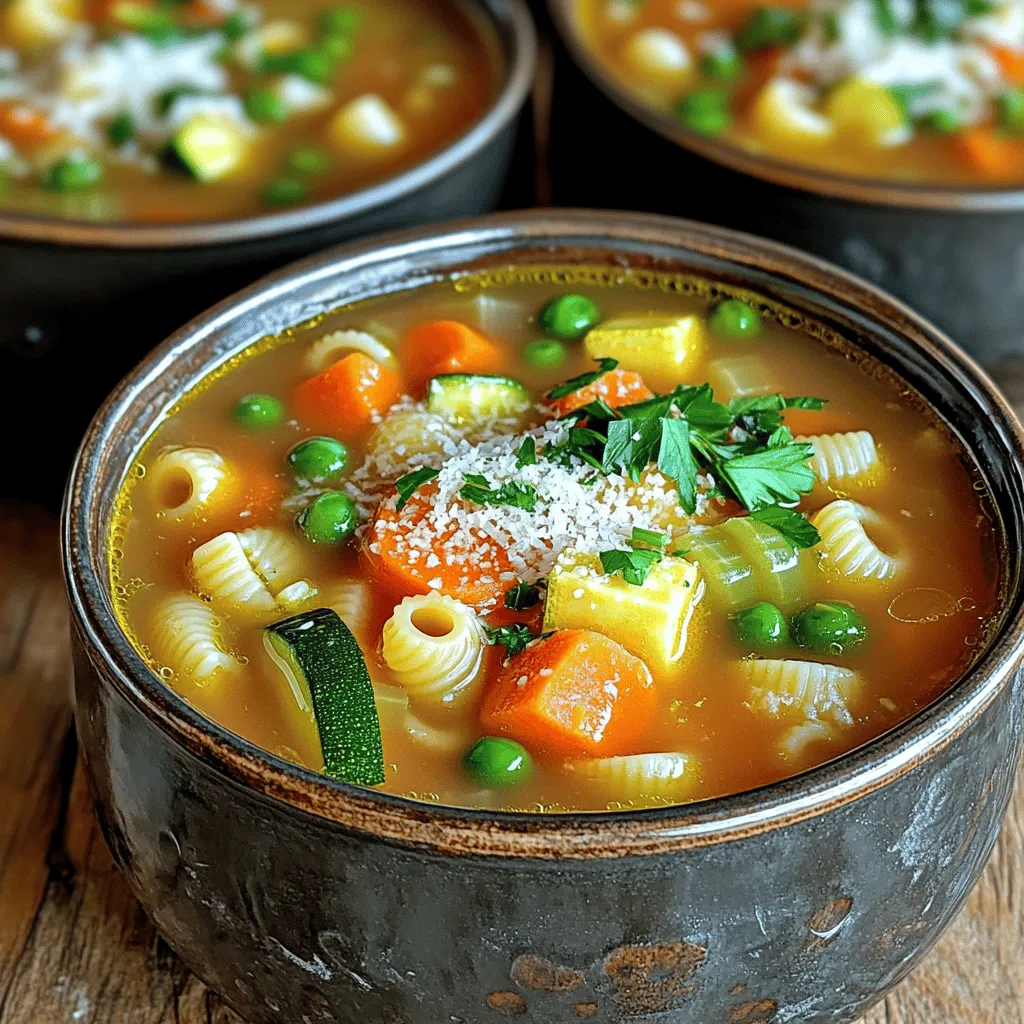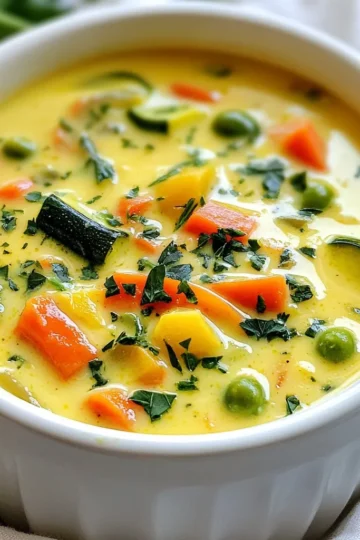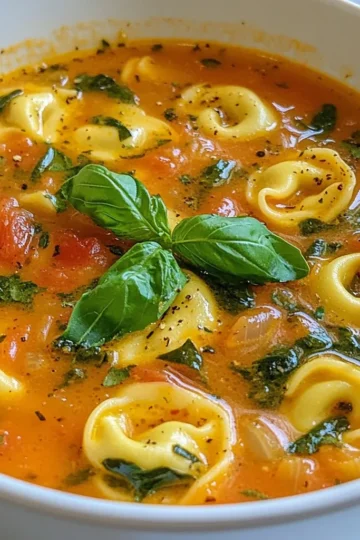Minestrone soup is a classic dish that's both simple and packed with flavor. With just a few fresh ingredients, you can create a warm, hearty meal that everyone will love. I’ll walk you through the must-have ingredients, share tips for perfecting your soup, and offer tasty variations. Whether you’re a seasoned cook or a beginner, this minestrone soup will satisfy your hunger and warm your soul!

Ingredients
Essential Ingredients for Minestrone Soup
To make a great minestrone soup, start with these key ingredients:
- 1 tablespoon olive oil
- 1 medium onion, diced
- 2 cloves garlic, minced
- 2 carrots, diced
- 2 celery stalks, diced
- 1 zucchini, diced
- 1 cup green beans, trimmed and cut into 1-inch pieces
- 1 can (15 oz) diced tomatoes, with juices
- 4 cups vegetable broth
- 1 can (15 oz) navy beans, drained and rinsed
- 1 cup small pasta (like ditalini or elbow)
- 1 teaspoon dried oregano
- 1 teaspoon dried basil
- Salt and pepper to taste
- 2 cups fresh spinach or kale, roughly chopped
These ingredients make a hearty and healthy soup. Each one adds a unique flavor or texture.
Optional Ingredients for Enhanced Flavor
For a richer taste, consider adding these optional ingredients:
- Grated Parmesan cheese (optional, for serving)
- Chopped fresh parsley (for garnish)
- A pinch of red pepper flakes for heat
- A splash of lemon juice for brightness
These extras can elevate your soup. They add more depth and a pop of color.
Possible Ingredient Substitutions
If you don't have something on hand, don't worry! Here are some easy swaps:
- Use any beans you have, like cannellini or black beans, instead of navy beans.
- Swap zucchini for yellow squash or bell peppers.
- If you lack pasta, try adding rice or quinoa instead.
- Use chicken broth if you want a meatier taste.
These substitutions keep your minestrone tasty and fresh. You can adjust the recipe based on what you have.
Step-by-Step Instructions
Preparing the Base of the Soup
Start by heating 1 tablespoon of olive oil in a large pot over medium heat. Once the oil is warm, add 1 medium onion, diced. Sauté the onion until it turns clear, about 5 minutes. This step adds sweetness to your soup. After that, stir in 2 cloves of minced garlic. Cook for another minute to release its aroma. Next, add 2 diced carrots and 2 diced celery stalks. Cook these for 5 minutes. They will soften and add a nice crunch.
Adding Vegetables and Building Flavor
Now it’s time to add more veggies. Toss in 1 diced zucchini and 1 cup of green beans, trimmed and cut into 1-inch pieces. Sauté these for about 4 minutes. This helps to build a solid flavor base. Then, pour in 1 can of diced tomatoes with juices and 4 cups of vegetable broth. Bring the mixture to a boil. This will enhance the soup’s richness.
Once it boils, reduce the heat to a simmer. Add 1 can of navy beans, drained and rinsed, along with 1 cup of small pasta like ditalini. Sprinkle in 1 teaspoon of dried oregano and 1 teaspoon of dried basil. Season with salt and pepper to taste. This mix of herbs makes your soup fragrant and delicious.
Cooking the Soup to Perfection
Let the soup simmer for about 10-12 minutes. You want the pasta to cook until it is al dente. After that, stir in 2 cups of fresh spinach or kale. Cook for another 2-3 minutes until the greens wilt. Check the taste and adjust seasoning if needed.
Now, you’re ready to serve! Ladle the soup into deep bowls. If you want, sprinkle grated Parmesan cheese on top. A little chopped fresh parsley makes a lovely garnish. Enjoy a warm, hearty bowl of minestrone, full of veggies and wholesome flavors!
Tips & Tricks
How to Achieve the Best Flavor
To get the best flavor in your minestrone soup, use fresh vegetables. Fresh veggies add bright tastes and great texture. Always chop your veggies evenly. This helps them cook at the same time. Sautéing the onions and garlic first builds a strong base. Add herbs like oregano and basil early. This lets their flavors bloom. Don't forget to season with salt and pepper. Taste as you go!
Time-Saving Tips for Busy Cooks
If you're short on time, try these tips. Prep your veggies ahead of time. Chop them the night before and store them in the fridge. Use canned beans and diced tomatoes. They save time and still have great taste. You can also use store-bought vegetable broth. If you like pasta, choose smaller shapes like ditalini. They cook fast and fit nicely in each bowl.
Common Mistakes to Avoid
Many people make simple mistakes when making minestrone soup. One common mistake is overcooking the pasta. This can make it mushy. Cook the pasta just until it’s al dente. Another mistake is skipping the seasoning. Always taste your soup before serving. Lastly, avoid cooking all the greens for too long. Add fresh spinach or kale near the end. This keeps their bright color and crispness.

Variations
Vegetarian and Vegan Minestrone Options
Minestrone soup is naturally great for vegetarians and vegans. You can keep the classic taste without meat. Use vegetable broth instead of chicken broth. For protein, the navy beans work well. They add texture and flavor. You can swap the Parmesan cheese for a vegan alternative if you like. Nutritional yeast is a tasty option to mimic that cheesy flavor.
Gluten-Free Adaptations
To make minestrone gluten-free, choose the right pasta. Look for gluten-free pasta brands. They come in many shapes and sizes. You can also skip the pasta and add more beans or veggies. Quinoa is a wonderful grain choice too. Just cook it separately and add it in at the end. This keeps the soup thick and hearty.
Creative Add-Ins for Unique Flavors
Want to spice up your minestrone? Try adding different herbs and spices. A pinch of red pepper flakes adds heat. Fresh herbs like basil or thyme give a great aroma. You can also toss in some diced bell peppers or corn. For a twist, add a splash of lemon juice before serving. This brightens the flavors and adds a nice zing. Explore these ideas to make your soup even better.
Storage Info
How to Store Leftover Minestrone Soup
To store leftover minestrone soup, let it cool first. Once cool, pour it into a bowl or container. Make sure to cover it tightly with a lid or plastic wrap. This way, it stays fresh in the fridge. You can keep it for up to three days. If you want to enjoy it later, freezing is a great option.
Tips for Freezing and Reheating
When freezing minestrone soup, use an airtight container or freezer bag. Label it with the date for easy tracking. The soup can last for up to three months in the freezer. When you're ready to eat, thaw it in the fridge overnight. To reheat, pour the soup into a pot and warm it on low heat. Stir often to prevent sticking.
Best Practices for Meal Prep
Meal prep with minestrone soup is easy and fun. You can make a big batch on the weekend. Store it in single-serving containers. This way, you have quick meals ready for busy days. You can also customize the soup for your taste. Add or remove veggies based on what you like. This keeps it fresh and exciting!
FAQs
What is the origin of Minestrone Soup?
Minestrone soup comes from Italy. It has a long history. The word "minestrone" means "big soup." People made it to use up leftover veggies. Each region in Italy has its own twist. Chefs add seasonal ingredients to make it unique. This soup is hearty and full of flavor. It reflects the Italian love for fresh produce.
Can I make Minestrone Soup in a slow cooker?
Yes, you can make minestrone in a slow cooker! Start by sautéing the onion and garlic. Then, add all the chopped veggies and beans. Pour in the broth and diced tomatoes. Set the slow cooker on low for 6 to 8 hours. This method lets the flavors blend nicely. Just add the pasta in the last 30 minutes to keep it firm.
How do I make Minestrone Soup healthier?
To make minestrone soup healthier, use low-sodium broth. You can also add more veggies. Spinach, kale, or even broccoli work well. Swap out pasta for whole grains, like quinoa or farro. This boosts fiber and nutrients. You can also reduce the amount of oil used. Enjoy a warm bowl of minestrone that’s both tasty and good for you.
Minestrone soup is a blend of essential and optional ingredients that create rich flavors. I shared step-by-step instructions to cook it just right. You learned tips to enhance taste and save time. I offered variations for every diet and detailed how to store leftovers. My final thought: Minestrone soup is versatile and easy. It warms your soul and suits any occasion. Enjoy experimenting with your own special twist!





Leave a Reply